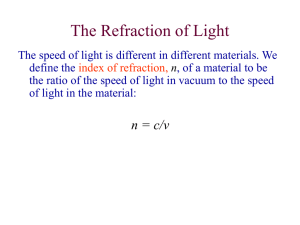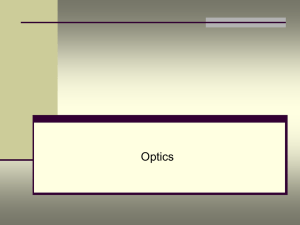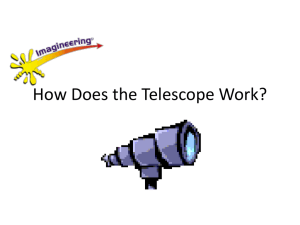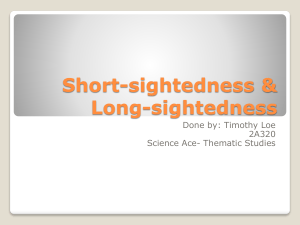Ch. 36 Clicker Questions . View as "slide show"
advertisement
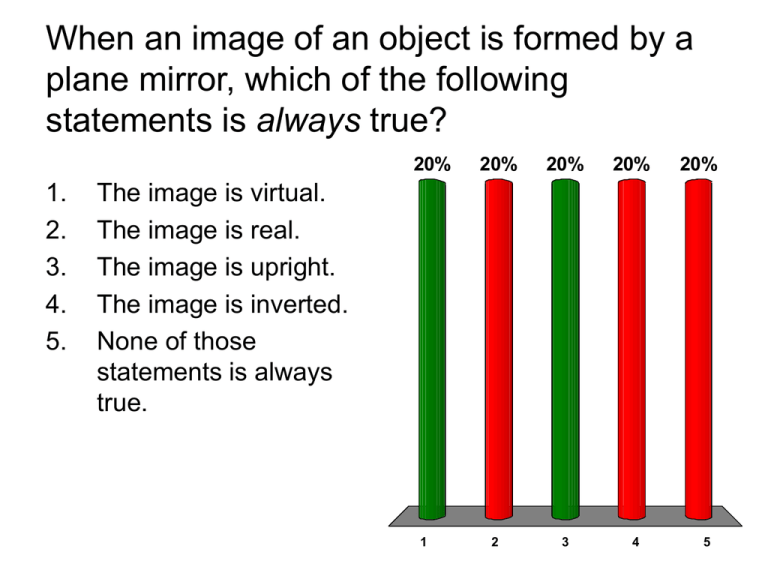
When an image of an object is formed by a plane mirror, which of the following statements is always true? 20% 1. 2. 3. 4. 5. 20% 20% 20% 3 4 20% The image is virtual. The image is real. The image is upright. The image is inverted. None of those statements is always true. 1 2 5 When the image of an object is formed by a concave mirror, which of the following statements are always true? 20% 1. 2. 3. 4. 5. 20% 20% 20% 3 4 20% The image is virtual. The image is real. The image is upright. The image is inverted. None of those statements is always true. 1 2 5 When the image of an object is formed by a convex mirror, which of the following statements are always true? 20% 1. 2. 3. 4. 5. 20% 20% 20% 3 4 20% The image is virtual. The image is real. The image is upright. The image is inverted. None of those statements is always true. 1 2 5 If you increase the aperture diameter of a camera by a factor of 3, how is the intensity of the light striking the film affected? 20% 1. 2. 3. 4. 5. 20% 20% 20% 3 4 20% It increases by factor of 3. It decreases by a factor of 3. It increases by a factor of 9. It decreases by a factor of 9. Increasing the aperture size doesn’t affect the intensity. 1 2 5 An object is located 50.0 cm from a converging lens having a focal length of 15.0 cm. Which of the following statements is true regarding the image formed by the lens? 20% 1. 2. 3. 4. 5. 20% 20% 20% 3 4 20% It is virtual, upright, and larger than the object. It is real, inverted, and smaller than the object. It is virtual, inverted, and smaller than the object. It is real, inverted, and larger than the object. It is real, upright, and larger than the object. 1 2 5 When an image of an object is formed by a converging lens, which of the following statements is always true? More than one statement may be correct. 20% 1. 2. 3. 4. 5. 20% 20% 20% 3 4 20% The image is virtual. The image is real. The image is upright. The image is inverted. None of those statements is always true. 1 2 5 When the image of an object is formed by a diverging lens, which of the statements is always true? More than one statement may be correct. 20% 1. 2. 3. 4. 5. 20% 20% 20% 3 4 20% The image is virtual. The image is real. The image is upright. The image is inverted. None of those statements is always true. 1 2 5 A converging lens made of crown glass has a focal length of 15.0 cm when used in air. If the lens is immersed in water, what is its focal length? 20% 1. 2. 3. 4. 5. 20% 20% 20% 3 4 20% negative less than 15.0 cm equal to 15.0 cm greater than 15.0 cm none of those answers 1 2 5 If Josh’s face is 30.0 cm in front of a concave shaving mirror creating an upright image 1.50 times as large as the object, what is the mirror’s focal length? 20% 1. 2. 3. 4. 5. 20% 20% 20% 3 4 20% 12.0 cm 20.0 cm 70.0 cm 90.0 cm none of those answers 1 2 5 Two thin lenses of focal lengths f1 = 15.0 and f2 = 10.0 cm, respectively, are separated by 35.0 cm along a common axis. The f1 lens is located to the left of the f2 lens. An object is now placed 50.0 cm to the left of the f1 lens, and a final image due to light passing though both lenses forms. By what factor is the final image different in size from the object? 20% 1. 2. 3. 4. 5. 20% 20% 20% 20% 0.600 1.20 2.40 3.60 none of those answers 1. 2. 3. 4. 5 Lulu looks at her image in a makeup mirror. It is enlarged when she is close to the mirror. As she backs away, the image becomes larger, then impossible to identify when she is 30.0 cm from the mirror, then upside down when she is beyond 30.0 cm, and finally small, clear, and upside down when she is much farther from the mirror. The mirror is: 1. convex. 2. plane. 3. concave. 33% 1 33% 2 33% 3 Lulu looks at her image in a makeup mirror. It is enlarged when she is close to the mirror. As she backs away, the image becomes larger, then impossible to identify when she is 30.0 cm from the mirror, then upside down when she is beyond 30.0 cm, and finally small, clear, and upside down when she is much farther from the mirror. What is the magnitude of its focal length? 20% 20% 20% 20% 20% 1. 2. 3. 4. 5. 0 15 cm 30 cm 60 cm ∞ 1 2 3 4 5 A person spearfishing from a boat sees a stationary fish a few meters away in a direction about 30° below the horizontal. To spear the fish, and assuming the spear does not change direction when it enters the water, the person should: 33% 33% 33% 1. aim above where he sees the fish. 2. aim below the fish. 3. aim precisely at the fish. 1 2 3 Model each of the following devices in use as consisting of a single converging lens. Rank the cases according to the ratio of the distance from the object to the lens to the focal length of the lens, from the largest ratio to the smallest. (a) a film-based movie projector showing a movie (b) a magnifying glass being used to examine a postage stamp (c) an astronomical refracting telescope being used to make a sharp image of stars on an electronic detector (d) a searchlight being used to produce a beam of parallel rays from a point source (e) a camera lens being used to photograph a soccer game 25% 1. 2. 3. 4. 25% 25% 2 3 25% b>a>e>c>d c>e>a>d>b e>d>c>b>a a>b>e>d>c 1 4 A converging lens in a vertical plane receives light from an object and forms an inverted image on a screen. An opaque card is then placed next to the lens, covering only the upper half of the lens. What happens to the image on the screen? 20% 1. 2. 3. 4. 5. 20% 20% 20% 3 4 20% The upper half of the image disappears. The lower half of the image disappears. The entire image disappears. The entire image is still visible, but is dimmer. No change in the image occurs. 1 2 5 A converging lens of focal length 8 cm forms a sharp image of an object on a screen. What is the smallest possible distance between the object and the screen? 20% 1. 2. 3. 4. 5. 20% 20% 20% 3 4 20% 0 4 cm 8 cm 16 cm 32 cm 1 2 5 The faceplate of a diving mask can be ground into a corrective lens for a diver who does not have perfect vision. The proper design allows the person to see clearly both under water and in the air. Normal eyeglasses have lenses with both the front and back surfaces curved. The lenses of a diving mask should be curved: 33% 33% 33% 1. on the outer surface only. 2. on the inner surface only. 3. on both surfaces. 1 2 3 An object, represented by a gray arrow, is placed in front of a plane mirror. Which of the diagrams in Figure OQ36.14 correctly describes the image, represented by the pink arrow? 25% 25% 25% 2 3 25% [Figure OQ36.14] 1. 2. 3. 4. a b c d 1 4


